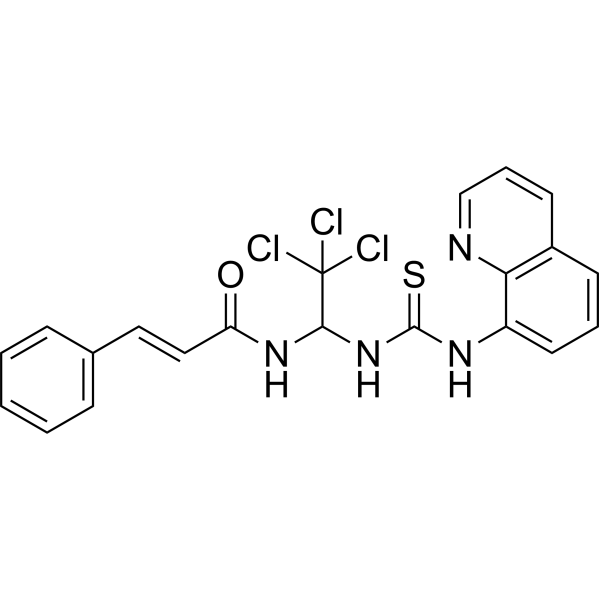Home
Products
Salubrinal



| Product Name | Salubrinal |
| Price: | Inquiry |
| Catalog No.: | CN00232 |
| CAS No.: | 405060-95-9 |
| Molecular Formula: | C21H17Cl3N4OS |
| Molecular Weight: | 479.81 g/mol |
| Purity: | >=98% |
| Type of Compound: | Alkaloids |
| Physical Desc.: | Powder |
| Source: | |
| Solvent: | Chloroform, Dichloromethane, Ethyl Acetate, DMSO, Acetone, etc. |
| SMILES: | O=C(NC(C(Cl)(Cl)Cl)NC(=S)Nc1cccc2c1nccc2)/C=C/c1ccccc1 |
| Contact us | |
|---|---|
| First Name: | |
| Last Name: | |
| E-mail: | |
| Question: | |
| Description | Salubrinal is a cell-permeable and selective inhibitor of eIF2α dephosphorylation. |
| Target | IC50: 1.7 µM (PP1)[1] |
| In Vitro | Salubrinal, a recently identified PP1 inhibitor capable to protect against endoplasmic reticulum (ER) stress in various model systems, strongly synergized with proteasome inhibitors to augment apoptotic death of different leukemic cell lines. Salubrinal preferentially seems to target the PP1/GADD34 complex, Salubrinal is of interest to examine whether the effect of Salubrinal could also be recapitulated by another inhibitor of this phosphatase. For this purpose cantharidin, wis selected, which is less toxic than okadaic acid, but which also blocks PP1 (IC50=1.7 µM) activities[1]. |
| In Vivo | Salubrinal is a synthetic chemical that inhibits de-phosphorylation of eukaryotic translation initiation factor 2 alpha (eIF2α). Salubrinal significantly suppresses inflammation of the paws of CAIA mice. For instance, the clinical scores are 1.94±1.7 (placebo) and 0.31±0.6 (Salubrinal) on day 6; and 4.63±3.4 (placebo) and 1.09±1.6 (Salubrinal) on day 12. Consistent with the clinical scores, the thickening of the paws is also reduced in the Salubrinal-treated group. Furthermore, Salubrinal reduces the histological scores from 1.47±1.10 (N=16; placebo) to 0.59±0.64 (N=16; Salubrinal) (p=0.01)[2]. |
| Cell Assay | Cellular viability is assessed by the WST-1 colorimetric assay. Assays are performed on 96 well plates with 2×104 K562 cells/well in triplicate with Salubrinal concentrations ranging from 5-75 µM (total volume of 200 µL, 18 hrs). Untreated cells served as negative control sample[1]. |
| Animal Admin | Mice[2] Using Balb/c female mice (~nine weeks old), CAIA is induced by intravenous injection of a 2 mg cocktail of ArthritoMAb antibodies on day 0 followed by intraperitoneal injection of 100 µg LPS on day 3. Mice are randomly divided into a placebo group and a Salubrinal-treated group. Salubrinal (2.0 mg/kg) is intravenously administered daily from day 0, while a solvent (49.5% PEG 400 and 0.5% Tween 80 in PBS) is administered to the placebo group. |
| Density | 1.5±0.1 g/cm3 |
| Exact Mass | 478.018860 |
| PSA | 98.14000 |
| LogP | 6.21 |
| Storage condition | Store at +4°C |